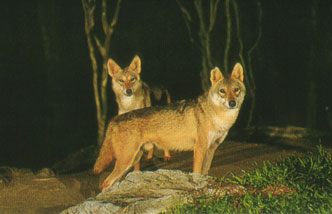
|
|
General Information
A wolf is a large predator that depends for its survival on large prey, such as deer, cattle and other hoofed animals that weigh up till a thousand pounds.
It has powerful jaws capable of exerting about 1500 pounds per square inch, or about twice that of the domestic dog.
It is accustomed to a feast and famine existence, often going many days without eating then gorging as much as 20 pounds in a single sitting.
It's role in nature is to remove the sick and the weak, and in this way create a win-win relationship with its prey.
The end result is a system which has succeeded for hundreds of thousands of years.
The wolf is a highly social animal, generally living within the same pack for most, if not all, of its life. Survival depends very much upon the pack.
The members of the pack cooperate in hunting, killing large prey, feeding and caring for the young, defending their territory against other packs, and so forth.
The pack functions mostly as a strong autocratic system, with each individual having fought for its placement or rank within the group. Generally only the top male and female are permitted to breed, while any attempts to do so by others are punished.
When to hunt, where to hunt, and many other activities are also commonly determined by the pack leaders.
Habitat
1999 Estimated Wild Wolf Populations in Asia:
Country
Wolf Population
Feeding and Breeding
There are usually 4 to 6 pups born in each litter. Pups are born inside a den. A den is sometimes a small cave or a hole dug out of the ground. The den must be big enough for the mother and her pups. It shelters them from the weather and protects the pups from other animals that may want to hurt them.
The gestation period is about 63 days. At birth, they weigh only 1 pound and their eyes are closed. Pups grow quickly. About 12 to 15 days after they are born they open their eyes.
By 2 weeks of age the pups can walk, and about a week after that they may come out of the den for the first time. At first they live only on milk from their mother.
In a few weeks they start eating more and more meat. This is brought to them in the stomachs of the adult wolves. The pups lick around the mouth of the adult and the food comes back up into the adult's mouth.
When pups are 6 months old they look almost like adult wolves. Around this time they start hunting with the rest of the pack.
Conservation
The Indian wolf is extremely difficult to conserve as a species when the majority of the human population is opposed to its survival. It has been losing ground to farmers and industry and losing its life for killing livestock.
Its numbers now have dropped to fewer than 2,000 animals, making it one of the most endangered and unpopular large predators in Asia. The first ever ecological study of this wolf started in 1988.
It was committed to gathering basic information on the wolf's behavior and ecology, both to provide the data for its conservation and to ease conflicts with farmers and herders.
Another 5 year study since 1996 is still being carried out with the help of Earthwatch volunteers to find out the current status of Indian wolves in the wild.
Data collected have shown that the Indian wolf population is less patchy and vulnerable (from a genetics point of view) and its range is more continuous than previously believed.
Given their role as top predators, wolves make excellent indicators of ecosystem health. Areas with high livestock predation (from whatever source) also suffer higher wolf mortality, because farmers shoot and poison the predators or they succumb to distemper spread by feral dogs.
Public education and compensation for livestock losses are critical components of any wolf conservation plan.
Interesting Facts
Though quite capable of ripping apart even the strongest of men, not a single documented case exists of a wolf having killed or even severely maimed anyone in the wild.
This is because the wolf in the wild, even when in the company of a large pack, is extremely fearful of people.It is rare that it even knowingly comes near them.
The link - "World of Lady Wolf" is a very interesting website devoted to the semi-wild wolf packs under study by wolf experts in Wolf Haven.
The story of the Sawtooth Pack (one of the wolf packs in Wolf Haven) was made into a documentary which I caught on Earthvisions last year. This is by far the best wolf documentary I ever watched as it is portrayed the everyday life of a wolf pack, the roles of individual wolves and their relationships with one another.
This show is capable of making a neutral person like wolves after watching it. In fact another wolf documentary actually showed a national park in Canada where tourists come from all over the world to hear the wolves howl in the evenings.
Perhaps the stereotype image people have of wolves is slowing changing, and the future of the wolf is not so bleak after all. May the song of the wolves be heard and eventually appreciated by all humans!
Bibliography
World of Lady Wolf
This website is best viewed using Internet Explorer at 800 X 600 resolution